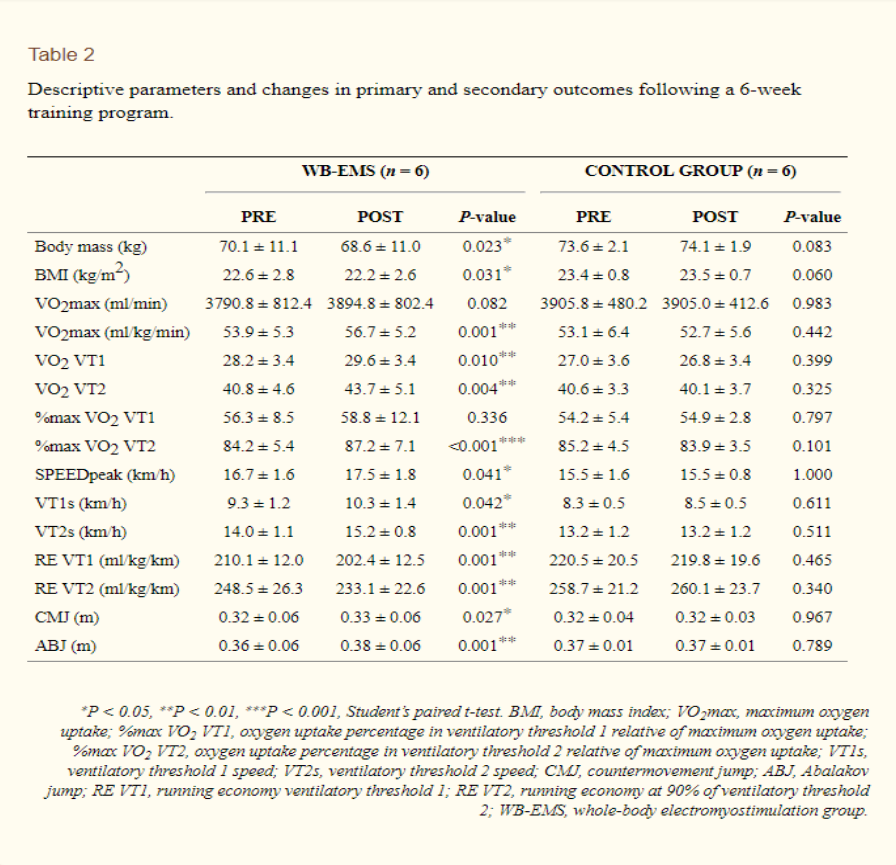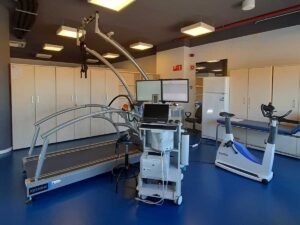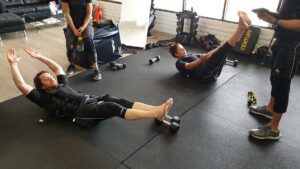Long distance running training depends on the interaction of physiological, biomechanical and psychological factors (Basett and Howley, 2000). Therefore, strength training has become an effective strategy to improve aerobic performance. (Mujika. 2017; Berryman et al. 2018). Full body electrostimulation (WB-EMS) improves body composition in women over 60 with obesity who have suffered loss of muscle mass (sarcopenic obesity) or risk of suffering and in physically inactive healthy middle-aged men (Kemmler et al . 2016b). Also, WB-EMS increases strength levels in soccer players (Flilipovic et al., 2016b).
Taking into account all the possibilities that full body electrostimulation can offer us in this study, periodized and functional effects were investigated with a WB-EMS training compared to a control group taking into account the running performance.
In the group with WB-EMS they reduced the training volume compared to the control group that maintained the volume and intensity of their career training.
The study involved 14 healthy male amateur runners of 26 years. None of the subjects had received training with WB-EMS. Participants who used WB-EMS had an adaptation program before starting the study training program.
Electrical parameters (frequency, pulse intensity and work cycle), volume (training session time and work recovery time) and perceived intensity (RPE) gradually increased throughout the 6 intervention sessions.
To measure the intensity of the electrical impulse, the Borg scale was used as a measure of the RPE.
The WB-EMS training consisted of 6 sessions, one per week and not exceeding 20 minutes of session. Participants completed 95.83% of the training sessions with WB-EMS.
The training was divided into 4 parts:
- W: Warm-up: 1 set of 7-10 repetitions of 3 exercises.
- S: Strength work: 2 sets of 5-10 repetitions of 6 exercises.
- HP: High intensity interval training: 1 series of 8 exercises performing maximum repetitions in 10 sg and 10 sg of rest between exercise).
- HT: High intensity interval training: Two series with intervals that were run on tape at two different intensities; moderate intensity (65% VO2max) and high intensity (> 85% VO2max).
The specific exercises of each training session have been described extensively in a previous study. (Amaro-Gahete et al., 2018).
In the following two tables we can see the electrostimulation protocols that were followed in each part of the 6 sessions (Table 1).



- Amaro-Gahet,FJ., De-la-OA., Sanchez-Delgado G., Robles-Gonzalez L., Jurado-Fasoli L., y Ruiz Jr., Gutierrez A., (2018) Whole-Body Electromyostimulation Improves Performance-Related Parameters in Runners. Front Physiol, 9 (1576).
- Bassett, D. R., and Howley, E. T. (2000). Limiting factors for maximum oxygen uptake and determinants of endurance performance. Med.Sci. Sports Exerc. 32, 70–84. doi: 10.1097/00005768-200001000-00012.
- Mujika, I. (2017). Quantification of training and competition loads in endurance sports: methods and applications. Int. J. Sports Physiol. Perform. 12, S29–S217. doi: 10.1123/ijspp.2016-2403.
- Berryman, N., Mujika, I., Arvisais, D., Roubeix, M., Binet, C., and Bosquet, L. (2018). Strength training for middle- and long-distance performance: a metaanalysis. Int. J. Sports Physiol. Perform. 13, 57–63. doi: 10.1123/ijspp.2017- 2032.
- Kemmler, W., Teschler, M., Weißenfels, A., Bebenek, M., Fröhlich, M., Kohl, M., et al. (2016b). Effects of whole-body electromyostimulation versus highintensity resistance exercise on body composition and strength: a randomized controlled study. Evid. Based Complement. Altern. Med. 3, 44–55. doi: 10.1155/ 2016/9236809.
- Filipovic, A., Grau, M., Kleinöder, H., Zimmer, P., Hollmann, W., and Bloch, W. (2016). Effects of a whole-body electrostimulation program on strength, sprinting, jumping, and kicking capacity in elite soccer players. J. Sports Sci. Med. 15, 639–648.
- Amaro-Gahete, F. J., De-la, O. A., Sanchez-Delgado, G., Robles-González, L., Jurado-Fasoli, L., Ruiz, J., et al. (2018). Functional exercise training and undulating periodization enhances the effect of whole-body electromyostimulation training on running performance. Front. Physiol. 9:720. doi: 10.3389/fphys.2018.00720.







